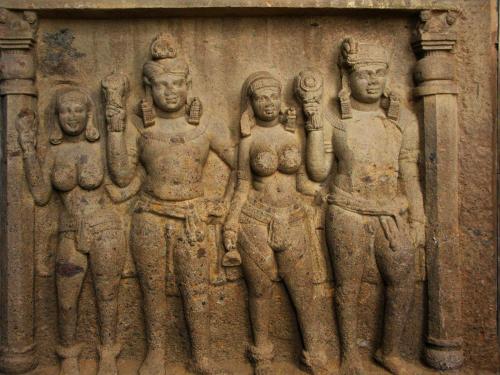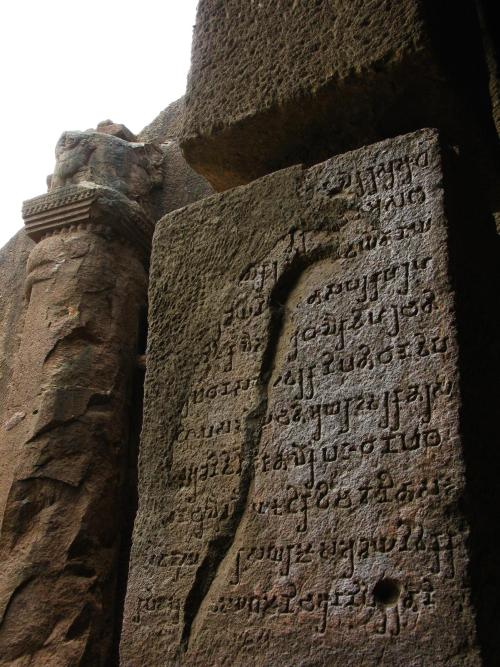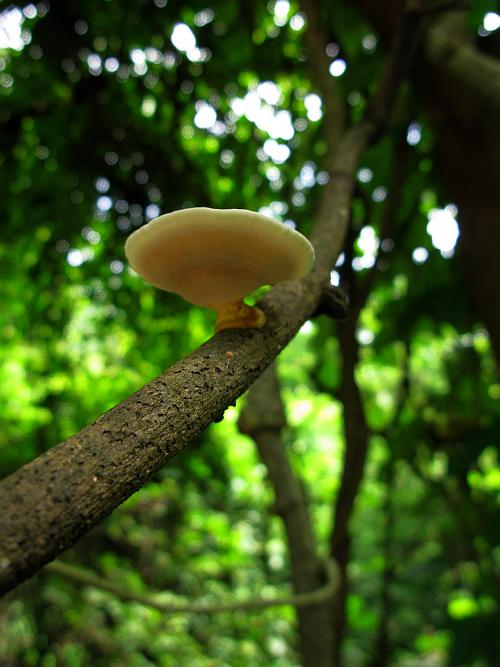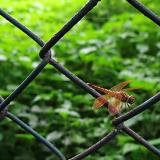After a week of bus rides, we were starting to miss the buzz of our Mahim Nature Park adventure. To make sure the following Sunday would be put to good use, we set our sights on a larger target, Sanjay Gandhi National Park.
Sanjay Gandhi National Park is a protected forest area in the Borivali suburb of Mumbai. Commonly referred to as Borivali National Park, it is the only national park in the world that lies inside the confines of a city. Considering Mumbai is one of the most populous and dense urban environments, that’s quite an astonishing thing.
Cow-feeding for pleasure and profit
Borivali is a good distance away from the old part of Mumbai. We decided to meet at the park gates at 8:30am, which meant having to get out from home quite early and take the train to make quick time.
The morning was cool but not cold, and the meagre clouds in the sky didn’t indicate any impending rain. The monsoon dry spell was continuing. Walking to the train station, we passed a temple where the early worshippers were paying their respects. A woman sat on the footpath with a large bundle of grass and a cow tied nearby, a common sight near temples. For a few Rupees, people are given some grass to feed the animal, a fortuitous beginning to the day. For the rest of us walking along the street, the cow is often something to pat along the way, some in reverence, some in friendly greeting, but most with a good amount of respect. Unlike what people outside India think, cows are not really holy in India, or formally worshipped, but they are considered an auspicious symbol along with many other plants and animals. If nothing else, they’re a friendly sight on the road as you go about your work for the day.
Railway repetitions
I’m not a big fan of trains, as I’m sure I’ve mentioned before, but they sometimes make sense on long journeys into the suburbs and when the weekday crowds are safely at home.
When we reached the station we bought our tickets at the counter. The station was a little dishevelled, which is the way train stations in Bombay always look, but you only notice it on weekends. On weekdays the sea of humanity that surrounds you covers up all other visual information.
On the ticketing and reservations building across one of the tracks, the station’s name was displayed in large three dimensional letters, in three different languages: English, Hindi and Marathi. Politics and political correctness are a wonderful thing. It looked like English and the other language repeated twice, because Hindi and Marathi both use the same script and proper nouns and titles are shared, even if they are different languages when spoken.
We got into an extra-fast train that would only stop at the Andheri station along the way before we reached our destination. Very convenient on any day, and today it was a pleasure, since the crowds were thin and the stations only mildly populated.
The compartments had been spruced up since I last travelled by a local Mumbai train. Things were more painted and less beaten up. The bars and hand-holds were shiny and a yellow LED display was placed above the door, indicating the next stop. Through the aluminium grill on the windows, the platform outside seemed to be getting busier as the day progressed. A female voice announced the departure of our train over the public address system, in three languages. We pulled out of the station on time with a characteristic electric hum as the train gathered speed, the hypnotic lattice of gleaming tracks and buildings next to the railway line blurred into a fluid oneness.
Recommended morning reading
Our compartment was not empty. An eclectic collection of Mumbai’s residents had taken their seats along the swaying iron beast. We had company on the hard benches we sat on too. We were four towards the window, which left two empty seats near the aisle facing each other. Two middle-aged gentlemen had separately occupied those seats before the train had left.
They were an interesting pair. The one sitting next to me had greying hair, wore a white shirt with a dark grey pair of trousers, and well-used shoes that had been polished with care. The man sitting opposite him was of a similar age, and quite similarly dressed, right down to some variation of a chunky gold watch on his wrist.
The man next to me had taken out a small booklet from his pocket and was reading it with rapt attention. The little book was very worn down, its tattered edges and frayed margins had seen many days in the man’s pocket. The book opened upward with small text letter-pressed in black into the rough paper. A vine pattern went along its sides, framing the pages in two vertical stripes of repeating foliage. It was in Marathi and it was scripture, one of the many mythological or philosophical works ever in favour, the short passages making their point in quick statements and poetic verse. I couldn’t read enough to tell what it was, but I didn’t want to peer too much and disturb the quiet reader on a Sunday morning.
The man across my seat was stockier than his counterpart. He sported a short beard and a head of deep orange hair, the whites and greys coloured with mehndi (henna). He was reading a broadsheet news paper in Urdu. If I tried, I could decipher some of the headlines, the Urdu script being borrowed from Arabic. But these more calligraphic shapes with the numerous vowel signs above and below the letters made the page swim in a watery pattern that overwhelmed my eyes. I looked out the barred windows and watched the blurring city instead.
Monsoon Clouds

Our train stopped at Dahisar, one stop after our destination, but in the Sunday morning lull, an auto rickshaw had us at the gates of the national park in a speedy ten minutes. The rest of our party was already there and after paying the entrance fee we strolled in.
The Sanjay Gandhi National Park is not very wild looking near its gates. If any thing, the manicured appearance of the tree line, the neat road going through planned gardens and public areas, the anxious morning walkers in their ritualistic garb staring accusingly at the rag-tag bunch of people with cameras who seem to be doing the blasphemy of enjoying themselves, all make you feel the ‘forest’ tag might be misplaced. But first impressions can be deceptive.
A few hundred metres after the gate, as the gardens, parks, and other amenities melted away behind us, the foliage got wilder and less planned. Krishna Giri is now a hill with a temple on it, close to the gate. Before Indian independence, that is what the entire forest was called, literally meaning dark/black mountain (more on that later). Past a left fork that might have led to the temple, the road veered off to the right hugging the contour of the hill and plunging into the wider forest. Some buildings could still be seen through the foliage on the right, the last bastions of human civilisation past the borders of the park, but the canopy was thick and very soon all signs of the outside world were lost.

It had started out as a sunny day when we left home but in this part of town, a strange phrase to be using in the middle of a forest, there were plenty of monsoon clouds to be seen. Not enough to consider it overcast, but enough to give the day the distinct flavour of the monsoon season, with startling views of what can only be described as architecture in the sky. The Sun seared through gaps and windows in the firmament, illuminating vast domes of cloud and massive curved walls of hanging rain.
Two dogs and a goat

Close to Krishna Giri, and on the outskirts of the park, we passed by some huts and small houses beside the road. This was a protected area, but people still lived here in tiny settlements. As we walked by, a stray dog trotted up to our group. Sometimes hanging back in pursuit, and sometimes weaving between us, he had made up his mind to follow. Maybe the weekend picnickers who came here provided him with the occasional feast.
Off to the left, along the base of the hill, we spotted some railway tracks through the trees. They were a simple set of narrow-gauge tracks with nothing else around, and they went off into the green in both directions, serving a tiny train that took people to and from the more popular spots in the park. A bunch of crows had found something of interest near the tracks, and as I walked closer to take some pictures, our canine friend went ahead and make sure everything was ok before he let me pass.
At the next settlement of huts, another dog joined our party. This one was a real brute, with a mangled face and the marks to show he had seen a few fierce fights. But he followed along in silence, looking at the forest on both sides with a casual attention. Somewhere along the way, our first four-legged friend turned off the road and disappeared into the trees. It would seem his jurisdiction ended here, or he had found something more interesting to investigate. The second dog continued along.
Another group of huts with red-tiled roofs appeared. A few people were going about their business for the day, carrying wood through the trees, drying things on mats in the Sun. A few roosters were running around between the houses, and a large white goat came onto the road nibbling at the weeds on the edges. For a while the goat trotted along behind us too, our canine guard ignored it, but after a while it stayed behind for greener pastures.


We came to a bridge where the road went over a flowing stream. Some people had stopped their motor bikes there to take in the view. A young girl sat on one edge of the bridge, which was just a slab of concrete with no railing. She was selling cucumbers, a refreshing snack for the weary travellers along the forest road. We stopped to take some pictures and rest for a while. As we left the sun-drenched piece of bridge, our canine companion stayed behind. He too had come to the end of his designated duties, but we had a lot further to go.
Forest light

The Sun played hide-and-seek through both the clouds and the leaves. As the kilometres went by the forest got denser, the atmosphere quieter, and the light that filtered through the dense groves all the more magical.

Other than the occasional vehicle driving by on the road there was only the silence of bird-song and insects announcing their presence in a regular rhythm. We were taking our time on the journey. I didn’t know at the time that it was a 7km walk to the end of the road. If we had simply marched along it would have been a much shorter walk, but there was less journeying and more browsing with our group. Colourful plants, strange insects and all manner of sights only to be seen in a forest kept us busy as we made our way forward.

We came to a check post where some forest rangers checked our passes. An old rusty road barricade with an ornate lion’s head sign on it that said “stop”, hung in the air above. We rested a few moments on the concrete benches nearby and went off the road into the trees. The terrain sloped upwards, then down, and at the base of the small hill, a lively brook bubbled over a channel of smooth rocks and stones. The water was open to the sky and while standing there in that tiny ravine surrounded by tall grass and wild flowers was beautiful, the Sun was starting to rise and the heat was getting stronger, so we plunged back up the hill towards the shade of the road.

Along the way there were some portions of road where the land flattened on to a plain, and the trees got denser. You could not see the Sun, its rays unable to penetrate the thick canopy overhead. Then suddenly, off the road there would appear a spot of sunlight, shining into a small meadow of green wilderness through a rogue opening amongst the trees. That forest light fills you with a feeling of comfort you just cannot describe in words or capture in photographs.

After a couple of hours on the trek, the trees gave way to open sky. A broad meadow of wild flowers spread out from the road to the left and looming above it all was a mountain of black rock with a slow waterfall trickling down one of its slopes and a squarish cave opening visible near the top. Those were the Kanheri Caves, and that is where we were heading.
Monkey business

The climb up to the caves was not an easy one. The gradient was steep but the dense trees provided some respite from the Sun. Eventually we found ourselves in a make-shift parking lot at the base of a set of stone stairs that rose further upward. Buses, cars and vans were strewn across the dirt lot. Families were everywhere doing that thing they all do on weekends, eat, and they had thrown around enough detritus to prove it. We climbed.
The stairs led to a broad area under towering trees, with a rudimentary cafeteria to serve the ever hungry tourists. An abandoned building stood at the far corner covered in deep green moss from the rains, and to the right a series of stone inclines went upwards towards the caves. We climbed the slopes, carved out into the side of the sheer rock, chisel marks providing just the right amount of grip to walk on.
In the trees, monkeys were making a ruckus, their lithe forms jumping between the branches, the stone slopes, and keeping a sharp eye out for any human slacking off with something edible in their hands. They were a riot of noise and food-snatching to rival any seasoned picnicker around them. Little surprise then, that the picnickers found them very amusing.
On the small plateau that surrounds the main cave shrine, trees were growing along the edge, over looking the sheer cliff that looked over the forest we had just travelled through. In the distance a few tall buildings could be seen through the haze, the only indications of the city that we were still inside.

We sat on the stout stone wall at the edge to catch our breath, and some of the calmer simians seemed to take our lead and perched themselves on a close by tree. While their cousins could be heard screaming in the distance, these few decided to relax for a while, grooming each other and pampering themselves into a lazy slumber. Monkey business comes in many flavours.
The spelunking Buddha

The shrines cut out of the live rock of the mountain side were over 2000 years old. These kind of time-spans are too vast for us to truly grasp, even if we understand them intellectually.

To the right, from where we sat, was a shallow open cave with a stupa. These mounds were originally used as a vault for relics of the Buddha. Over the millennia they grew more elaborate and became revered themselves. To the left was a more recessed cave. A stone pillar marked the opening, and a colonnaded entrance hid the dark chamber behind it.
Nothing prepares you to see a 20-something metre long hall with ornate pillars and a vaulted ceiling all cut from a single chunk of rock, when you step into a dark entrance at the side of a mountain. It is breathtaking. And to think a bunch of monks worked for centuries to achieve this masterpiece makes every one of your meagre achievements stand in stark contrast to the sheer audacity of what these people managed to do so long ago.

The chamber, called a chaitya, served as a meeting and prayer hall in its heyday, the centre of a complex of 109 small caves spread all over this mountain top. When it was complete, Kanheri was a major Buddhist university and a central hub of trade routes that extended through the Konkan coast all the way to Mesopotamia. The deep chamber seemed to suck in the sunlight from the outside, or perhaps it was the fine chisel work on the stone surfaces that reflected back the sparse light with a quiet brilliance. Along the sides, intricate pillars, each with their own unique sculptures, marched into the depths of the mountain, protecting the dark alcove behind them and leading the eyes towards the simple stone stupa at the end of the hall. There someone had lit a single lamp to keep the light in Kanheri burning bright after all these millennia.


Outside the hall, hidden from the sun, two large relief sculptures of the standing Buddha guarded the entrance on two sides, facing inward. And right next to the main door, reliefs of men and women in their sparse classical clothing looked on with smiles and laughter, seeming to celebrate life rather than delve into the depths of spiritual despair as is often the case in monuments such as these. The way they stood made it look like a casual holiday snapshot, rather than a formal portrait, and for a brief moment the millennia between us disappeared and two sets of human beings looked on each other in friendly greeting.

A large stone slab chiselled with the ancient Bhrami script urged tantalisingly to be deciphered, and in side chambers, more exquisite sculptures of the Buddha were on display, all cut from the single rock face, and all intricate to a startling degree. The two thousand year old rock still displayed the fine folds of the garments, the delicate ringlets of hair on that now ubiquitous dome-shaped head, and the gentle smile seemed to have never faltered.

We spent some time out side the great chaitya hall, taking pictures and just soaking in the atmosphere. Hassled week-enders rushed in and out of the darkened chamber, wanting to complete their visit to the fullest while we sat on ancient stone stairs in dark alcoves, with the passing sight-seers giving us curious stares. It is a shame that places such as this are visited by people with no understanding or respect for what the architects were trying to achieve to begin with, a place of calm and contemplation, far removed from the buzz of the marketplace and the politics of the capitals, where the human mind could wander fruitfully.
Americans vs Indians
We did try to climb further into the higher reaches of the complex, but the weekend crowd was dense and it didn’t seem like a good idea to try to tick off every one of the 109 caves and reservoirs on this trip for the sake of completeness. I was sure the caves would not go anywhere soon, so we turned back and headed down the mountain.
Among the crowds, one stand-out feature had been the handful of American families I’d come across. Bombay is visited by many tourists, of course, but they are more often European, or British, or lone American backpackers. Families from the US are a rare sight, but maybe the increased India hype had pushed some to experiment.
Climbing down from the caves to the shaded cafeteria area, there were now more people heading up. It was past mid-day, and the late weekend crowd was now trooping in. An American family with two little kids was heading out down the path, and an Indian family with two small kids of their own were heading in. I don’t whose idea it was but soon the Indian kids were sitting down with the American kids and the parents were taking pictures. Sensing their position as star animal attraction at the caves being usurped, the monkeys stared on in silent disbelief.
Child coloured glasses
We quickly clambered down the mountain to plunge into the cool shaded comfort of the forest road. Heading back to civilisation through the lush canopy I thought back to the wonders atop that mountain and I understood why. Why people had found this place in the middle of a dense forest, why they had chosen to stay here, and why they had decided to set up such a large temple of learning at the top of this isolated mountain so long ago. They saw this place for the wonder it was and that realisation inspired them to pay homage to it with wonders of their own.

Nature has the market on wonders of every scale cornered with no room for competition. From the tiniest creepy crawlies to the tall trees and the massive mountains, the natural world produces things of such startling beauty that human beings can never aspire to equal. But you would have to be very frigid of imagination for all this to not affect you, to not think on being faced by such beauty that there was something greater than you in the universe and that something greater was worth investigating.

Alas, we have all lost that wonder, that sight, that fascination with the world around us, that respect of that which we do not understand. Which is why the hordes of perpetually famished, every noisy weekend time-wasters come to this forest every week, drive through its august paths blaring their horns and discarding their plastic bags, but never once standing still and staring in awe at what lies about them now and what some brave and/or crazy people built here so long ago. They have lost what they will make sure their offspring lose at the earliest, as their child-coloured glasses get crushed underfoot in the unending stampede of aimless progress.
Barefoot in the forest

It was a hot afternoon, but bearable under the blanketing trees. For a brief spell the sky had threatened to send a shower, but there had been none. Since it had rained in the night these past few days, small puddles still stood in the potholes and the depressions along the tarred road.
After an entire morning on my feet, the wet tar seemed like a attractive prospect, so I held my slippers in my hand and continued walking. The ground was rough and smooth, cool and warm in patches, and this made the experience of walking back a different one from our trek in the opposite direction this morning. On some patches of bad terrain the slippers went back on, but they remained off for very long stretches.
Our feet are covered in footwear so often that we forget how much sensation the foot provides of the ground below. Walking there in the green tent of trees in the middle of a forest on an uneven road, just heightened that realisation to new levels.
The traffic going towards the caves was much higher now. Every few minutes, at most, a vehicle would pass by packed to the gills with people in colourful clothes, distinctly over-dressed for visiting a cave. The road was uneven, and it was necessary for us to walk on the edge because that was the only space available, a valid compromise for a place that didn’t get enough traffic and didn’t need the further human invasion of a footpath. But, many of the delicate souls in their big cars deemed it necessary to try to mow us down because they couldn’t be bothered to turn the steering wheel a little, even if they were on the wrong side of the road. After plenty of stopping and starting to wait for them to pass, I decided not to. We continued to walk on the edge of the road, and let the impatient drivers make their own way around us. They still tried to mow us down sometimes, but it takes more than most people have to play chicken with a human being who does not cower, especially when he is swinging slippers in his hands in a mildly threatening manner.
River juice
As always the walk back was quicker, because we knew what to expect and also because we stopped less to take photographs. We made it out the gate as the late afternoon Sun was starting to dip. A drinking water fountain outside provided a welcome relief from the dust and dirt we had collected on our persons with glee along the way, but the forest was behind us and the jungle lay ahead.
The gate to the Sanjay Gandhi National Park lies on the Western Express Highway. We crossed the road and dived into a small restaurant there, the name now escapes me. After a good work-out like that, I’m rarely hungry, not for solid food anyway. Everyone felt the same so a round of fresh juices was ordered. After the inevitable long pauses trying to decide, the order ended up being a watermelon juice and a whole bunch of Ganga-Jamunas.
For the un-initiated the Ganga and the Jamuna are two of India’s major rivers. The Ganga-Jamuna is a mixed juice of equal parts orange and mosambi(sweet lemon), a refreshing mixture and a great pick-me-up after a long day. As we ordered, there was some confusion about what the ingredients were. Some of us were confused between the Ganga-Jamuna and another drink called the Mara-Mari (literally, fisticuffs or violence, in Hindi). One was orange and mosambi, and the other was pineapple and mosambi. Either was fine with us so we just ordered, and let the rivers flow as they might.
Bus blessings
Refreshed, we said our farewells and headed off in our own directions. By now the Sun was lower and the clouds to the west had begun to take on a warmer tinge. The train had been a convenient way to get here, but it was now later in the day, the stations would be more crowded, and we just wanted to relax in a bus and watch the world go by.
The BEST has started a new air-conditioned luxury bus service over the past few years called BRTS, which is a treat to travel by. Since we needed to go a fair distance back home, we decided to track one down. After a few enquiries we were told the closest one left from a bus depot some distance along the highway, so we got on the first regular bus we could find and headed for the Magathane Bus Depot.
When we got there the last BRTS bus for the day had left and we were a bit stranded. We walked back out on to the highway to take our chances at the regular bus stop. A few minutes passed and out of the haze of traffic the distinct purple silhouette of a BRTS bus loomed down the road. As far as we knew it didn’t stop here, but we put our hands out expecting it to pass us by with the surging traffic.
It stopped. This particular bus started somewhere earlier along the highway and it was empty, so the driver and conductor had decided to make the unscheduled stop when we flagged them. It was a lucky break and a comforting way to end our day of journeying. The bus remained fairly empty, and as it went up and down flyovers along the highway, towers of cumulus monsoon clouds stood high at the horizon, dwarfing all the human structures in front of them. As the Sun lowered for the evening, one half of the sky turned a deep pink and the heavy cotton clouds across the firmament shone a brighter white in salute.
The swaying ashoka tree
We were home quite early and settled in for a quiet evening, sharing stories of our day’s adventures with my Grandmother. As dusk turned to that deep evening gloom when even lights seem unable to penetrate the darkness, the cloudy sky finally gave way and it rained a heavy torrent.
It had rained in the middle of the night while I was asleep, the past few days, but this was the first real rain I was witnessing since I got here and it was awesome.
Sitting there in the balcony of my Grandmother’s home with a proper monsoon rain lashing the Earth outside brought back so many childhood memories. Memories of hours spent there stretching my hand out to feel the falling water, memories of my Mother preparing hot drinks and fried foods in the kitchen to ward away the rainy chill, memories of paper boats cast off into the large pool of water that collected down-stairs, before the compound was tiled, all of it under the shade of the tall ashoka tree(Mast Tree) in the corner, swaying with the wind. That ashoka tree was still there, and it was now twice as tall as it had been when I was a kid. It still stood there braving the rains, and it still danced in the wet monsoon breeze.
Samir
Liked this article? Please share it: ![]()
![]()
![]()
![]()
![]()
![]()



Thanks Samir, brilliant pictures. I have not visited the Kanheri caves, but the statues and stupas are very reminiscent of Ajanta caves. Did you get a chance to go to Aurangabad this trip?
Samir, as always is a pleasure reading your stories, in a style I absolutely adore, your rich description makes us readers even smell the grass or stones, see the light, the reflection of colors, thank you for your time,in this article, and thanks for sharing a little of your childhood and memories.
Magali
Hi Samir – I second magali above in that you have a knack for telling stories and taking the reader along with you on those journeys, and actually feel the freshness of the leaves or silence of the jungle…. very nice pictures as well.. so thank you so much for sharing with us.. look forward to reading more…